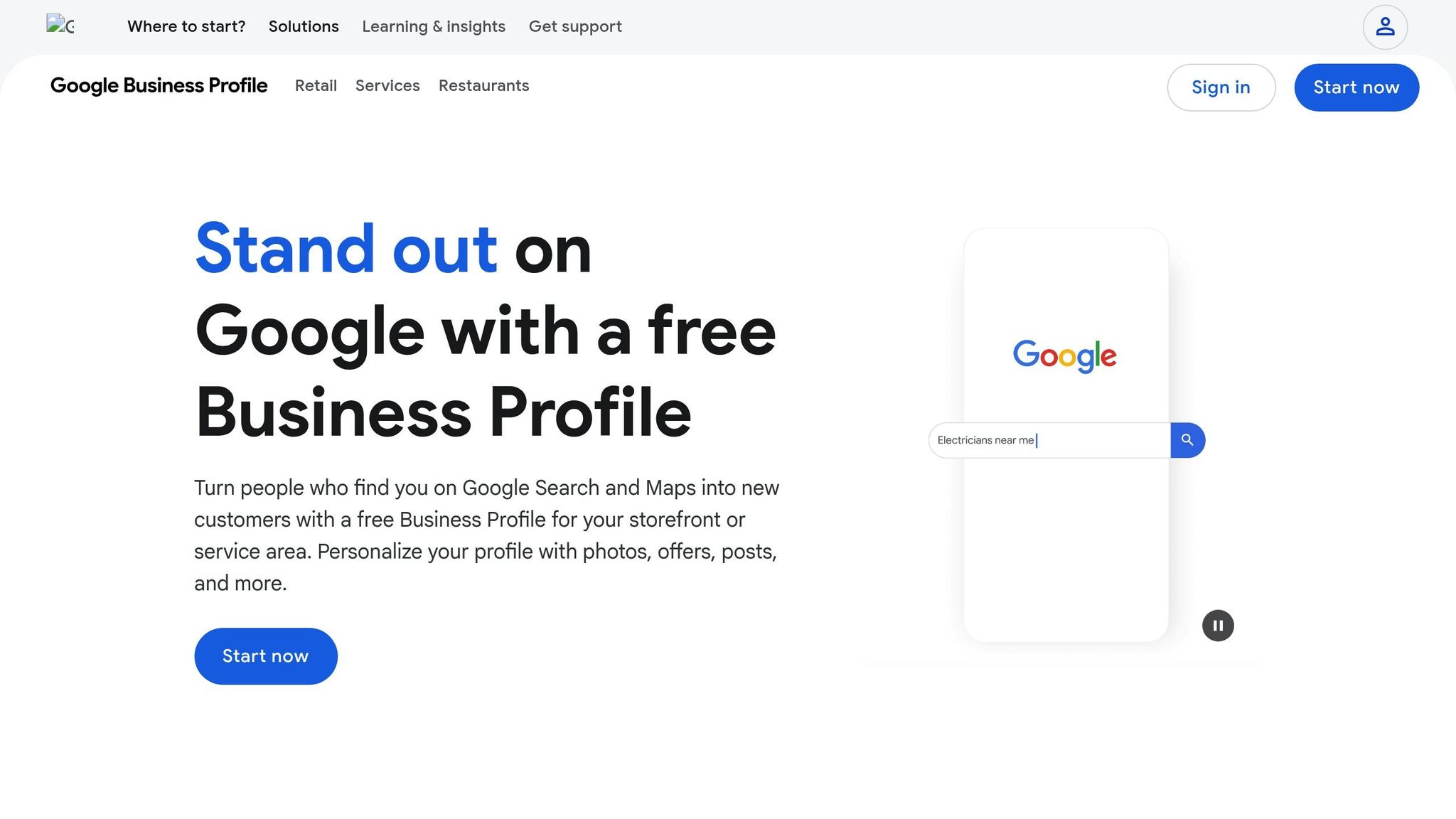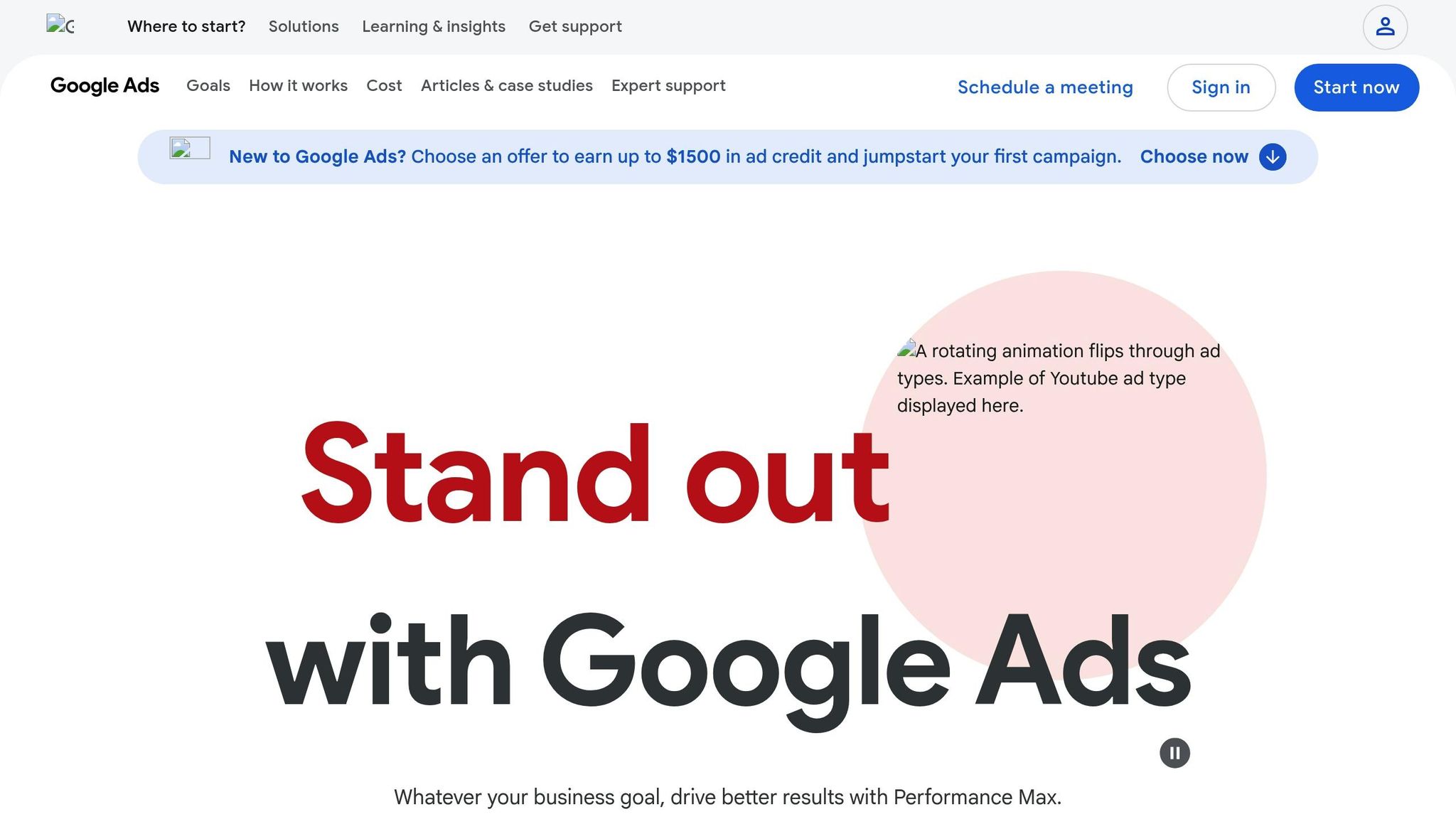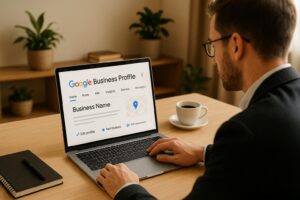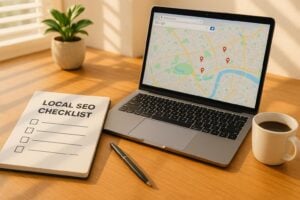Your Google Business Profile is a powerful tool to attract local customers. A fully optimized profile can increase your chances of being featured in Google’s “Local Pack,” boosting visibility and engagement. Here’s a quick summary of what you need to do:
- Claim and Verify Your Profile: Ensure you own your profile and complete Google’s verification process. Double-check details like your business name, address, and contact information.
- Keep Information Accurate: Ensure your name, address, and phone number (NAP) are consistent across all platforms. Update business hours and other details as needed.
- Add Photos and Videos: High-quality visuals can increase customer engagement. Include interior, exterior, and product photos, along with short videos or virtual tours.
- Manage Reviews and Q&A: Respond to reviews promptly and address customer questions in the Q&A section. Positive interactions build trust and credibility.
- Leverage Advanced Features: Add products, services, and attributes to your profile. Enable messaging and booking options for easier customer interaction.
- Stay Updated: Regularly review and refresh your profile to reflect changes in services, hours, or offerings.
A well-maintained profile can lead to 42% more direction requests and 35% more website clicks, making it a crucial part of your local marketing strategy. Keep your profile active and relevant to convert searches into customers.
Claim and Verify Your Google Business Profile

Taking control of your Google Business Profile is the first step to boosting your local visibility. By claiming ownership, you unlock features that can help attract local customers and leads.
How to Claim Your Profile
Head over to the Google Business Profile website and log in with your Google account. If you don’t have one, create an account using your business email.
Next, search for your business using its exact name and address. Be thorough – Google or even your customers may have already created a listing. If your business shows up, click "Claim this business" next to the correct listing.
To avoid missing an existing listing, try variations of your business name. Use abbreviations, include your full address, and even test common misspellings your customers might use. If multiple listings exist, claim the one that’s most accurate and request Google to remove the duplicates through their support tools.
If your business doesn’t appear in the search results, click "Add your business to Google" and carefully enter your details. Use the exact name displayed on your storefront or official documents.
For businesses with multiple locations, create a separate profile for each one. Each location needs its own unique address and phone number to avoid confusion and ensure accuracy.
Once you’ve claimed your listing, the next step is verification, which unlocks full access to your profile’s features.
Complete the Verification Process
Verification confirms you’re the rightful owner and gives you full control of your Google Business Profile. Google offers several ways to verify, depending on your business type and online presence.
Phone and email verification are the quickest methods for businesses with a strong online presence or active Google Ads accounts. These can often be completed in just a few minutes.
For most businesses, postcard verification is the standard process. Google will mail a postcard with a unique verification code to your business address, which typically arrives in 5-7 days. Double-check your address to prevent delays.
If your postcard doesn’t arrive within 14 days, log into your profile dashboard and select "Resend verification code." You’re allowed up to two resends. If issues persist, ensure your address matches official records and reach out to Google Support for help.
Service-area businesses – those that visit customers at their locations – should leave the address field blank and use the service area feature instead. This ensures compliance with Google’s guidelines while still letting you define the areas you serve.
Once verified, make sure all your business details are accurate and consistent across every platform.
Keep Business Information Consistent
Consistency in your business information helps build trust with both customers and Google’s algorithm, which can directly impact your local search rankings. Your name, address, and phone number (NAP) should be identical across your website, social media profiles, local directories, and any other listings.
Even small inconsistencies can hurt your search rankings or, worse, lead to your profile being suspended. Use the same phone number everywhere – ideally, a direct line to your business rather than a call center. Ensure your website URL is up-to-date and directs customers to the most relevant page, like your homepage or a specific landing page.
Regular updates are key to maintaining accuracy. If you move, change your phone number, or adjust your business hours, update this information immediately across all platforms. Outdated details can frustrate customers and signal to Google that your business isn’t actively managed.
For those who want to save time and avoid errors, UENI offers a done-for-you service that includes setting up and verifying your Google Business Profile. As part of their website package, they ensure your profile is correctly configured and consistent with your website, helping you avoid costly mistakes that could hurt your local visibility.
Add Complete Business Information
Your Google Business Profile can be a game-changer when it’s packed with accurate and detailed information. Profiles that are fully completed are 50% more likely to lead to a purchase, giving customers the confidence they need to choose your business.
Add Business Details
Start with your business name, and make sure it matches exactly what’s on your storefront, legal documents, and branding materials. Don’t add extra details like locations, keywords, or promotional phrases (e.g., "Best Pizza in Chicago!"). Google’s policies require you to stick to your official business name.
Your address should be precise and thorough. If your business is in a multi-unit building, include details like suite numbers, floor levels, or building names. For instance, "123 Main Street, Suite 205" ensures customers can find you easily and avoids mix-ups with other businesses in the same location.
Provide a direct phone number so customers can reach you without hassle. Avoid using call centers or automated systems that could frustrate potential clients. For example, if you’re running a small restaurant, list the number that connects directly to your host station rather than a third-party reservation service.
Link to your website URL, directing users to the most relevant landing page for conversions. Make sure your site is mobile-friendly and loads quickly, as most local searches happen on smartphones.
When listing business hours, use the 12-hour format (e.g., 9:00 AM – 5:00 PM) and update them for each day of the week. Don’t forget to adjust for holidays or special events. For example, if your retail store is closed on Sundays but open on major holidays, make those exceptions clear to avoid losing potential customers.
Choose Relevant Categories and Attributes
After entering the basics, refine your profile with the right categories. Your primary category is crucial – it helps Google understand your business and determines when you appear in search results. Be as specific as possible. For example, a business specializing in water heater repairs should select "Plumber" rather than "Home Services."
Secondary categories let you highlight additional services or specialties. A plumber might add "Water Heater Installation" or "Drain Cleaning" as secondary categories. Similarly, a bakery could choose "Bakery" as the primary category and add "Café" or "Cake Shop" if they serve coffee or specialize in custom cakes.
Attributes allow you to showcase features that might sway customer decisions. For example, a restaurant could highlight "Outdoor Seating" or "Vegetarian Options", while a medical office might include "Wheelchair Accessible" or "Telehealth Services." Choose attributes that reflect your actual offerings. Don’t select options like "Women-owned" or "Black-owned" unless they genuinely apply, as these help customers find businesses that align with their values.
Write a Clear Business Description
Your business description is your chance to stand out. With up to 750 characters, focus on what makes your business valuable and the specific benefits you offer. Avoid generic claims about quality or service.
For example, a landscaping company might write: "We provide professional lawn care and landscape design for residential and commercial properties in the Greater Seattle area. Our team is licensed, insured, and dedicated to transforming outdoor spaces using sustainable practices and local plant expertise."
Incorporate local keywords naturally to boost your visibility in area-specific searches. An Austin bakery might mention "Austin wedding cakes" or "custom birthday cakes Austin" to attract couples planning weddings or parents organizing parties.
Stay away from over-the-top language like "best", "top-rated", or excessive punctuation. Instead, focus on concrete details about your services, experience, or specialties. For instance, a dental practice could say, "We offer comprehensive family dentistry, including preventive care, cosmetic treatments, and emergency services."
UENI’s service can simplify this process by setting up your profile with optimized descriptions and accurate categorization. Their team ensures your profile aligns perfectly with your website, building trust with customers and Google’s algorithm. This integrated approach saves time and avoids common mistakes that could hurt your local search visibility.
Use as much of the character limit as possible, but keep your description clear and purposeful. Every word should help potential customers understand what you do and why they should choose you. This step completes the foundation of your business profile.
Add Photos and Videos to Your Profile
Visuals play a crucial role in making your Google Business Profile stand out. They’re not just eye-catching – they build trust. Businesses with photos see 42% more requests for directions and 35% more website clicks compared to those without visuals. Think of your photos and videos as your digital storefront; they deserve the same care and attention as your physical location. Here’s how to create and showcase high-quality visual content.
Upload High-Quality Photos
Start with your cover photo, the first image people see when they visit your profile. This picture should immediately communicate what your business is about and leave a great first impression. For example, a restaurant might highlight its signature dish or cozy dining area, while a dental office could feature a sleek and modern treatment room.
Your profile photo is equally important – it’s your logo or an image that represents your brand. This photo shows up in search results and on maps, so keep it simple, clear, and easy to recognize.
Beyond these key images, consider uploading other types of photos to give potential customers a well-rounded view of your business:
- Exterior shots: Help people find your location easily.
- Interior photos: Highlight your space’s ambiance and layout.
- Team photos: Add a personal touch by showing the faces behind the business.
- Product and service photos: Show off what you offer, like a bakery displaying its pastries or a landscaping company showcasing completed projects.
Make sure your photos meet these technical requirements: JPG or PNG format, between 10 KB and 5 MB, and at least 720×720 pixels. Keep them well-lit, in focus, and avoid overusing filters or adding text overlays. Aim to upload at least three high-quality photos for each category, and refresh your visuals regularly to reflect updates like renovations, new products, or team changes.
Add Videos and Virtual Tours
Videos breathe life into your profile in ways photos simply can’t. Google allows videos up to 30 seconds long, with a minimum resolution of 720p and a maximum file size of 75 MB. Use videos to showcase your offerings, facilities, or even customer testimonials. For example, a gym might create a quick tour of its workout areas, while a restaurant could feature a chef preparing a signature dish.
For an even more immersive experience, consider adding a 360-degree virtual tour. These tours let customers explore your space as if they were physically there, and listings with virtual tours are twice as likely to capture interest. Hiring a Google-certified photographer for this can be a smart move, especially if your space is a major selling point. Businesses like real estate agencies, event venues, hotels, and retail stores often see great results from virtual tours.
If creating visual content feels overwhelming, companies like UENI can help. They provide photography and video production as part of their Google Business Profile optimization services. Their team ensures your visuals are high-quality, aligned with your brand, and consistent across all platforms – making your profile look polished and professional.
Don’t let your visual content go stale. Review your photos and videos every few months, and update them to reflect seasonal changes, new products, or improvements to your business. Keeping your visuals current not only keeps customers engaged but also signals to search engines that your business is active and thriving.
Manage Customer Reviews and Questions
Your Google Business Profile serves as a central spot where customers can evaluate your reliability. Alongside detailed business information and appealing visuals, reviews play a critical role in shaping perceptions. In fact, 87% of people say they’d only consider a business with an average rating of 3–5 stars. Even more compelling, businesses that respond to reviews are seen as 1.7x more trustworthy than those that don’t. This makes managing reviews and questions a must for building credibility and attracting potential customers. Let’s dive into how you can effectively handle reviews and questions.
Get and Respond to Reviews
Timing is everything when asking for reviews. The best moment? Right after a customer has had a positive experience. Train your team to make requests in person or follow up via email. For example, a bakery could include a direct review link on receipts, while a service company might send a thank-you email after completing a job.
Avoid offering incentives for reviews – this violates Google’s policies and could lead to penalties. Instead, make the process easy by providing clear instructions and explaining how reviews help your business improve and serve the community.
When responding to reviews, act quickly and with a personal touch. Thank positive reviewers with a heartfelt note, and address negative feedback directly. For instance, a reply to a glowing review might say: "Thanks so much for your kind words, John! We’re thrilled you enjoyed our service."
For negative reviews, show empathy and a willingness to resolve the issue. A professional response could look like this: "We’re sorry to hear about your experience, Sarah. Please give us a call at (555) 123-4567 so we can address your concerns." This approach not only reassures the unhappy customer but also signals to others that you’re proactive and customer-focused.
Speed matters, too – 53% of customers expect a response to negative reviews within a week, but aiming for 24–48 hours is even better. Slow responses can erode trust, while prompt replies show you’re attentive and professional.
Answer Questions in the Q&A Section
The Q&A section of your Google Business Profile is often overlooked but can be a game-changer. This is where potential customers come for quick answers about your business, and timely responses can make the difference between gaining or losing a customer.
Stay on top of this section by regularly monitoring and answering questions promptly. When someone asks about store hours, pricing, or services, they’re often ready to make a purchase decision. Delays in responding could send them straight to a competitor.
Take control by pre-populating the Q&A with common questions and clear answers. For instance, a restaurant might add: "Do you offer gluten-free options?" with a brief response about their menu. A dental office could include: "Do you accept walk-ins?" with details about their scheduling policies.
When replying, be specific and helpful. If someone asks about parking, don’t just say "yes." Instead, provide details like where the parking is located and whether it’s free. These small touches reduce uncertainties and make customers feel more confident about choosing your business.
Keep in mind that anyone can answer questions in this section. By staying active, you can prevent misinformation from being posted by well-meaning but uninformed users. Your official responses carry more weight and ensure accuracy.
Use Google Posts for Updates
Google Posts are a fantastic way to share timely updates, offers, or announcements directly on your profile. These posts stand out prominently and can include eye-catching images, concise text, and clear calls to action like "Book Now" or "Learn More."
Aim to post weekly to keep your profile fresh and engaging. Content about limited-time deals, new products, or local events tends to attract the most attention. For example, a fitness studio might post: "Join our Summer Bootcamp! Sign up by June 15 for a 10% discount," paired with a vibrant photo of their workout space.
You can also use Posts to highlight customer stories, introduce new services, or share behind-the-scenes glimpses of your business. Posts remain visible for seven days (or until the event date passes), so frequent updates signal to both customers and search engines that your business is active and thriving.
If managing reviews, questions, and posts feels overwhelming, services like UENI can help. They offer tailored Google Business Profile management, handling everything from monitoring reviews to crafting professional responses and creating engaging posts. This allows you to focus on running your business while ensuring your online presence stays polished and up-to-date.
Consistency is the secret to success. Regularly engaging with reviews, staying proactive in the Q&A section, and keeping your profile dynamic with fresh Google Posts will not only build trust but also improve your visibility in local searches. Together, these efforts drive more qualified leads straight to your business.
sbb-itb-5b82b38
Use Advanced Google Business Profile Features
Once you’ve nailed the basics of your Google Business Profile, it’s time to take things up a notch. These advanced features can help you attract more local leads, boost customer engagement, and make your business stand out. Did you know that businesses with complete Google Business Profiles are 2.7 times more likely to be seen as trustworthy and 70% more likely to receive location visits? Here’s how you can use these tools to your advantage.
Add Products and Services
Think of your Google Business Profile as a digital storefront where you can showcase your products or services. By adding detailed descriptions and prices, you give potential customers a clear idea of what you offer – making it easier for them to decide before they even reach out.
To get started, log in to your profile dashboard and head to the "Products" or "Services" section. Each item should have:
- A clear name
- A detailed description
- Pricing in U.S. dollars (e.g., $49.99)
- High-quality images to make it visually appealing
When writing descriptions, focus on what makes your offerings stand out. Use terms and keywords that locals are likely to search for. For instance:
- A hair salon might list:
"Men’s Haircut – $25.00: Professional haircut and styling for men, includes wash and finish." - A bakery could write:
"Custom Wedding Cake – Starting at $150.00: Hand-decorated three-tier cake with your choice of flavors and personalized design. Serves 50 guests."
Keeping your listings updated is crucial. If prices change or you have new products or seasonal offerings, make sure your profile reflects that. Detailed, up-to-date listings with photos can significantly increase customer engagement.
Set Up Messaging and Booking Options
Sometimes, the difference between a casual browser and a paying customer is how easy it is to connect with you. By enabling messaging on your profile, you allow customers to reach out instantly. Combine this with booking tools like "Reserve with Google", and you make scheduling appointments seamless.
Quick responses are essential. Aim to reply within a few hours during business hours, and set up phone notifications to avoid missing any messages. For service-based businesses, booking tools are a game-changer. They simplify the scheduling process, reduce back-and-forth communication, and even minimize no-shows with automatic confirmations and reminders.
If you’re not sure how to set this up, platforms like UENI can handle the technical details, ensuring everything runs smoothly. Once messaging and booking are in place, you can take it a step further by linking your profile with Google Ads and Merchant Center.
Connect to Google Ads and Merchant Center

Want to maximize your visibility in search results? Integrating your Google Business Profile with Google Ads and Merchant Center is the way to go. This ensures your business details – like hours and contact info – stay consistent across Google’s services.
With this setup, your local ad campaigns become more powerful. For example, ads can display real-time information, such as your current hours or a special promotion. If you’re in retail, linking to Google Merchant Center lets your products appear in Google Shopping results. Shoppers will see photos, prices, and availability – often above organic search results.
This integration also gives you access to analytics, so you can track which ads drive the most visits, calls, or clicks. It’s a valuable tool for refining your marketing strategy and optimizing your budget.
Think about the customer journey: someone searching for "Italian restaurant near me" might see your ad, click to view your profile, browse your menu, and book a table – all without leaving Google. This streamlined experience can lead to higher conversion rates.
If the technical setup feels overwhelming, consider outsourcing to professionals who specialize in Google integrations. The goal is to create a seamless, cohesive online presence that works across all Google platforms, making it easier for customers to find and engage with your business.
Keep Your Google Business Profile Updated
Keeping your Google Business Profile up to date can make a big difference. Businesses with fully updated profiles are 2.7 times more likely to be seen as reputable and attract seven times more clicks compared to those with outdated information. On the flip side, outdated details – like incorrect holiday hours or a disconnected phone number – can frustrate customers and leave a lasting bad impression.
Review Your Profile Regularly
Make it a habit to review your profile every month. Ensure that your business name, address, phone number, and website are consistent across all platforms. This consistency not only builds customer trust but also aligns with Google’s algorithm requirements.
As your business grows, your profile should evolve too. For example, if your restaurant starts offering catering services or your retail store begins accepting contactless payments, update your categories and attributes to reflect these changes. Also, refresh your business description with current offerings and relevant keywords that local customers might use when searching.
Don’t forget to review your service areas. If your business expands or changes its focus, update these areas to ensure you’re targeting the right local audience. To stay on top of everything, consider creating a simple checklist for your monthly reviews.
While keeping your information accurate is essential, diving into your profile’s insights can help you optimize its performance even further.
Check Insights and Analytics
Your Google Business Profile insights offer a treasure trove of information about how customers discover and interact with your business. For instance, the "How customers search for your business" section reveals whether people are finding you through direct searches (typing your business name) or discovery searches (looking for a type of business).
Pay attention to customer actions such as calls, website clicks, and requests for directions. These metrics can give you a clear picture of how potential customers engage with your profile. Adding updated visuals, like fresh photos, can also boost engagement.
Instead of focusing on one-off data points, look for trends over time. For example, insights can help you identify your busiest days and times, which can inform staffing decisions, inspire targeted posts for slower periods, or even lead to adjustments in your business hours to better serve your customers.
If managing these updates feels overwhelming, services like UENI’s concierge offerings can handle the heavy lifting. They’ll keep your profile optimized and up to date, so you can focus on running your business.
Lastly, set up notifications for profile changes. Google or even customers may suggest edits, and responding to these quickly shows that you’re actively managing your profile. This kind of attention not only keeps your profile accurate but also strengthens your online visibility.
Regular updates, combined with insights-driven adjustments, ensure your profile remains a powerful tool for attracting local customers and generating leads.
Conclusion
A well-optimized Google Business Profile can completely change how local customers find and interact with your business. By following this checklist – claiming and verifying your profile, filling out all business details, uploading sharp, high-quality photos, managing customer reviews, and taking advantage of advanced features – you increase your local visibility and attract more leads. Each step plays a part in building a stronger connection with potential customers.
Here’s the proof: a complete profile builds twice the trust with customers, while quality photos can lead to 42% more requests for directions and 35% more clicks to your website. Plus, 64% of consumers turn to Google Business Profiles to find contact details for local businesses.
Staying engaged is just as important. Responding to reviews signals that you value customer feedback, which matters because 91% of consumers read online reviews, and 84% trust them just as much as personal recommendations.
The secret to long-term success? Consistency and regular updates. Your Google Business Profile isn’t something you set up once and forget about – it’s a living, breathing representation of your business. Whether it’s updating seasonal hours, adding new services, or sharing recent photos, keeping your profile fresh ensures your business stays relevant and visible in local search results.
For small business owners juggling daily tasks, managing an optimized profile can feel like a lot. That’s where services like UENI’s concierge offerings come in handy, taking care of the ongoing updates so you can focus on your customers. By sticking to this checklist, you align every part of your online presence to turn local searches into real leads.
Your Google Business Profile is often the first impression customers have of your business. Use these strategies consistently to stand out, grow your visibility, and bring in more local customers.
FAQs
How can I keep my Google Business Profile information consistent across all platforms?
To keep your Google Business Profile consistent, make sure your business name, address, phone number (NAP), and other essential details are identical across all platforms where your business appears. This includes your website, social media accounts, and local directories.
It’s a good idea to periodically review your profile to confirm that updates – like new operating hours or contact details – are accurately reflected everywhere. Using a centralized tool or document to track this information can make managing it much easier. Consistency doesn’t just enhance your credibility; it also helps improve your local SEO rankings.
What should I do if my Google Business Profile verification postcard doesn’t arrive?
If your Google Business Profile verification postcard hasn’t shown up after 14 days, start by double-checking the address listed in your profile settings. Make sure there aren’t any typos or missing details like suite or unit numbers that could delay delivery.
If everything looks correct, you can request a new postcard. Just log into your Google Business Profile account, click “Verify Now”, and follow the instructions to resend it. Still no luck? Contact Google Support to troubleshoot the issue or explore other ways to complete the verification process.
How can I use Google Posts to keep my Google Business Profile engaging and updated?
Google Posts offer an excellent way to share updates, promotions, events, and news directly through your Google Business Profile. They help keep your business visible and relevant to potential customers. To make the most of them, focus on crafting clear, concise content that showcases what’s new or valuable about your business.
Use attention-grabbing images and include a strong call-to-action, such as "Call Now" or "Learn More", to encourage engagement. Keep your posts timely by sharing updates like seasonal promotions, upcoming events, or new product launches. Since posts expire after seven days, regular updates are key to keeping your profile fresh and inviting.









